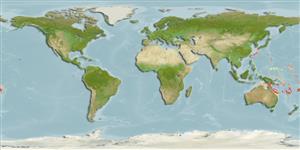Classification / Names
Noms communs | Synonymes | Catalog of Fishes(Genre, Espèce) | ITIS | CoL | WoRMS | Cloffa
>
Perciformes/Scorpaenoidei (Scorpionfishes) >
Scorpaenidae (Scorpionfishes or rockfishes) > Scorpaeninae
Etymology: Scorpaenopsis: Latin, scorpaena = a kind of fish, 1706 + Greek, opsis = appearance (Ref. 45335); eschmeyeri: Named for William N. Eschmeyer, in recognition of his research on the Scorpaenidae..
More on authors: Randall & Greenfield.
Environment: milieu / climate zone / depth range / distribution range
Écologie
marin démersal; profondeur 1 - 24 m (Ref. 57579). Subtropical
Southwestern Pacific: Fiji and New Caledonia.
Taille / Poids / Âge
Maturity: Lm ? range ? - ? cm
Max length : 7.6 cm SL mâle / non sexé; (Ref. 57579); 11.5 cm SL (female)
Description synthétique
Morphologie | Morphométrie
Épines dorsales (Total): 12; Rayons mous dorsaux (Total): 9; Épines anales 3; Rayons mous anaux: 5. Diagnosis: Dorsal rays XII,9; anal rays III,5; pectoral rays 17-18 (rarely 18). Longitudinal scale series 44--48 (modally 46). Body depth 2.8-3.05 in SL; head length (HL) 2.2-2.3 in SL; snout length 3.0-3.15 in HL; orbit diameter 4.65--4.95 in HL; nearly one-half of orbit extending above dorsal profile of head; interorbital width 6.75-7.2 in HL. Pair of interorbital ridges flaring posteriorly, then curving medially to join slight incurved ridge at front of occipital pit; median interorbital ridge extending half way back in interorbital space; occipital pit shallow and not flat. Coronal spines and pretympanic spines absent. Suborbital pit not well developed; suborbital ridge with 4 spines, the first on lacrimal; two ventral spines on lacrimal, one directed mainly anteriorly and the other curving posteriorly. First dorsal spine 1.9-2.4 in second spine; third dorsal spine longest, 2.2-2.7 in HL; eleventh dorsal spine 1.55-2.0 in twelfth spine; second anal spine 1.65-2.0 in HL. Supraoccipital tentacle absent. Body color variable, the darkest blotches usually above tip of upper opercular spine, two on lateral line, two obliquely above and forward of these, two in soft portion of dorsal fin, and one in anal fin (Ref. 57579).
Inhabits coral reef. Benthic (Ref. 75154).
Life cycle and mating behavior
Maturité | Reproduction | Frai | Œufs | Fécondité | Larves
Randall, J.E. and D.W. Greenfield, 2004. Two new scorpionfishes (Scorpaenidae) from the South Pacific. Proc. Calif. Acad. Sci. 55(9):384-394. (Ref. 57579)
Statut dans la liste rouge de l'IUCN (Ref. 130435)
Menace pour l'homme
Venomous
Utilisations par l'homme
Plus d'informations
Noms communsSynonymesMétabolismePrédateursÉcotoxicologieReproductionMaturitéFraiRassemblement de ponteFéconditéŒufsDéveloppement de l'œuf
Taille/ÂgeCroissanceLongueur-poidsLongueur-longueurFréquences de longueursMorphométrieMorphologieLarvesDynamique des populations larvairesRecrutementAbondanceBRUVS
RéférencesAquacultureProfil d'aquacultureSouchesGénétiqueElectrophoresesHéritabilitéPathologiesTraitementNutrientsMass conversion
CollaborateursImagesStamps, Coins Misc.SonsCiguateraVitesseType de nageSurface branchialeOtolithesCerveauxVision
Outils
Articles particuliers
Télécharger en XML
Sources Internet
Estimates based on models
Preferred temperature (Ref.
123201): 24.7 - 27.9, mean 26.5 °C (based on 307 cells).
Phylogenetic diversity index (Ref.
82804): PD
50 = 0.5000 [Uniqueness, from 0.5 = low to 2.0 = high].
Bayesian length-weight: a=0.01259 (0.00606 - 0.02615), b=3.03 (2.86 - 3.20), in cm total length, based on LWR estimates for this (Sub)family-body shape (Ref.
93245).
Niveau trophique (Ref.
69278): 3.9 ±0.7 se; based on size and trophs of closest relatives
Résilience (Ref.
120179): Milieu, temps minimum de doublement de population : 1,4 à 4,4 années (Preliminary K or Fecundity.).
Fishing Vulnerability (Ref.
59153): Low vulnerability (10 of 100).
